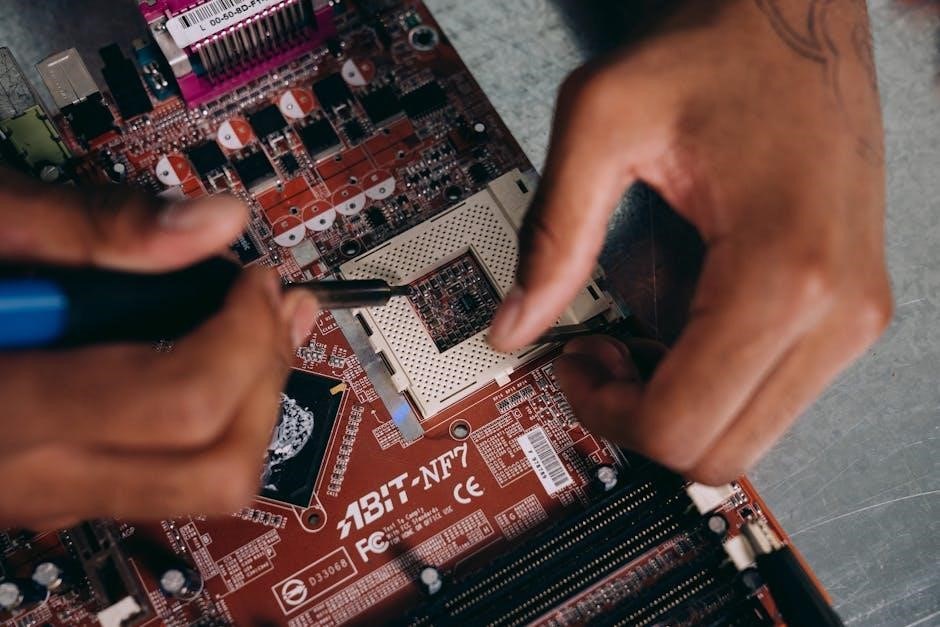Manual airbrushing is a versatile technique utilizing compressed air to spray paint, offering beginners easy tips for stunning results․ It’s a special process!
This art form has evolved over time, becoming a crucial skill for model painting, illustration, and even automotive customization․
What is Manual Airbrushing?
Manual airbrushing represents a captivating artistic process where paint is atomized and propelled onto a surface using compressed air, controlled directly by the artist’s hand․ Unlike automated systems, manual airbrushing demands skill and precision, allowing for nuanced control over lines, dots, and overall coverage․
It’s more than just spraying paint; it’s about building up layers and achieving smooth transitions․ This technique is frequently employed in model making, where it allows for incredibly detailed finishes․ The ability to shade effectively is a key component, often achieved by mixing transparent black for subtle tonal variations․
Essentially, it’s a method of applying paint with exceptional control, enabling artists to create breathtaking visuals․
History of the Manual Airbrush
The origins of the manual airbrush trace back to the late 19th century, initially developed for retouching photographs and illustrations․ Early models were cumbersome, relying on simple mechanics to atomize paint․ Over time, advancements in design and materials led to more refined and user-friendly instruments․
Throughout the 20th century, the airbrush gained prominence in commercial art, particularly in advertising and automotive customization; Artists discovered its potential for creating smooth gradients and realistic effects․
The rise of model painting further fueled its popularity, with enthusiasts embracing the technique for achieving professional-quality finishes․ Today, the airbrush continues to evolve, with ongoing innovations in air compressors and paint formulations, solidifying its place as a vital tool for artists across diverse disciplines․

Essential Equipment for Manual Airbrushing
Successful airbrushing requires key tools: an airbrush itself, a reliable air compressor, and appropriate airbrush paints – foundational for any beginner’s journey;
Types of Manual Airbrushes
Manual airbrushes come in several distinct types, each suited for different applications and skill levels․ Single-action airbrushes are often recommended for beginners due to their simplicity; they control airflow with one trigger, while paint flow is managed separately․ This allows for easier control of coverage․
Double-action airbrushes, however, offer greater versatility․ These require simultaneous control of both airflow and paint flow with a single trigger pull, enabling nuanced shading and detailed work․ They are favored by experienced artists for illustrative airbrushing and complex model painting․
Furthermore, airbrushes vary in nozzle size, influencing the line width and paint flow․ Smaller nozzles are ideal for fine details, while larger nozzles are better for broader coverage․ Choosing the right type depends on your intended projects and desired level of control․
Air Compressors: A Crucial Component
Air compressors are absolutely essential for effective manual airbrushing, providing the consistent compressed air needed to atomize paint․ Unlike canned air, compressors deliver sustained pressure, crucial for smooth, even coats and detailed work․ Selecting the right compressor involves considering its PSI (pounds per square inch) output and tank size․

Higher PSI allows for finer detail, while a larger tank ensures consistent pressure and reduces compressor cycling․ Oil-free compressors are popular for their low maintenance, but oil-lubricated models often offer quieter operation and longer lifespan․
Proper electrical safety when using an air compressor is paramount, and a regulator is vital for air pressure control, the foundation of quality airbrushing․
Airbrush Paints: Choosing the Right Medium
Selecting the correct airbrush paint is vital for achieving desired results in manual airbrushing․ Paints are categorized by their base – water-based, solvent-based, and acrylic․ Water-based paints are beginner-friendly, easy to clean, and less toxic, but may require more coats for full coverage․
Solvent-based paints offer durability and excellent adhesion, ideal for automotive airbrushing, but demand careful handling and ventilation․ Acrylics strike a balance, providing versatility and good performance․
Understanding paint viscosity and thinning ratios is key; transparent black is a useful mixing component․ Always choose paints specifically designed for airbrush use to prevent clogging and ensure smooth spraying․

Basic Airbrushing Techniques
Mastering air pressure control and proper airbrush holding are foundational․ Practice lines, dots, and consistent coverage – these basics unlock your airbrush journey!
Holding the Airbrush Correctly
Achieving consistent results with a manual airbrush begins with a proper grip․ Think of holding a pen or pencil – a relaxed, comfortable hold is paramount․ Avoid a death grip, as tension translates directly into unsteady lines and uneven paint flow․
Generally, hold the airbrush with your dominant hand, using your index finger to control the trigger․ Your thumb and middle finger provide stability and guidance․ The non-dominant hand should support the airbrush, acting as a pivot point for smooth, controlled movements․
Experiment with different grips to find what feels most natural for you․ Remember, a relaxed and balanced hold is key to unlocking the full potential of your airbrushing technique․ Consistent practice will refine your grip and improve your control․
Air Pressure Control: The Foundation of Quality
Mastering air pressure is arguably the most crucial aspect of manual airbrushing․ It directly impacts paint flow, spray pattern, and overall finish quality․ Lower pressures (around 15-20 PSI) are ideal for fine detail work and delicate lines, offering greater control․
Higher pressures (25-35 PSI) are better suited for larger areas and achieving full coverage, but require a steadier hand․ Start with a lower pressure and gradually increase it until you achieve the desired effect․
Consistent pressure is vital; fluctuations will result in inconsistent paint application․ A regulator on your air compressor is essential for precise control․ Remember, understanding and adjusting air pressure is the foundation for exceptional airbrush results․
Basic Spraying Techniques: Lines, Dots, and Coverage
Developing fundamental spraying techniques is key to airbrush proficiency․ Start with simple exercises: creating consistent lines by moving the airbrush smoothly and at a constant speed․ Practice varying line thickness by adjusting distance and air pressure․
For dots, use a quick, controlled trigger press and release․ Achieving even coverage requires overlapping passes, maintaining a consistent distance from the surface․ Avoid “puddling” by using sufficient air pressure and not applying too much paint at once․
These basic skills form the building blocks for more complex techniques․ Consistent practice will build muscle memory and improve your control over the airbrush․

Advanced Airbrushing Techniques

Mastering layering, blending, and masking unlocks incredible detail and realism․ These techniques build upon the basics, creating smooth transitions and sharp lines․
Layering and Building Tone
Layering is a fundamental advanced technique in manual airbrushing, allowing artists to gradually build up color and create depth․ Instead of attempting to achieve the desired shade in a single pass, multiple thin coats of paint are applied․
Each layer subtly alters the tone, resulting in smoother transitions and more realistic effects․ This method is particularly effective for rendering shadows and highlights, adding dimension to your artwork․ Begin with lighter values and progressively introduce darker shades, ensuring each layer is fully dry before applying the next․
Controlling air pressure is crucial during this process, maintaining a consistent spray pattern for even coverage․ Patience is key; building tone through layering takes time, but the results are well worth the effort, offering unparalleled control and nuance․
Blending and Smooth Transitions
Achieving seamless blending and smooth transitions is a hallmark of skilled manual airbrushing․ This relies heavily on controlled application and understanding how colors interact․ Begin by applying the lighter color, then introduce the darker shade while overlapping the edge of the first․
Reduce air pressure slightly to soften the transition zone․ Feathering the spray – moving the airbrush quickly in and out – helps diffuse the color and eliminate harsh lines․ Practice is essential to develop a feel for the optimal distance and speed․
Transparent colors are invaluable for blending, allowing underlying layers to show through․ Remember, subtle adjustments are preferable to heavy-handed applications; build up the blend gradually for a natural, realistic effect․
Masking Techniques for Sharp Lines
Masking is critical for creating crisp, defined edges in manual airbrushing․ Several methods exist, from commercially available masking fluids and tapes to creating custom stencils․ Masking fluid provides a protective barrier, applied before spraying, and peeled off afterward․ Ensure it’s fully dry to prevent bleeding․
Low-tack masking tape is ideal for straight lines, carefully pressed down to avoid paint creeping underneath․ For complex shapes, consider using pre-cut or hand-cut stencils made from materials like acetate or vinyl․
Always apply light coats of paint to minimize the risk of lifting the mask․ Patience and precision are key; a well-executed masking technique elevates your airbrush work significantly․

Airbrushing Applications
Manual airbrushing excels in diverse fields like model painting, detailed illustration, and stunning automotive artistry, offering unparalleled control and finesse․
Model Painting with Airbrush
Manual airbrushing revolutionizes model painting, moving beyond brushes for superior control and finish․ This technique allows for incredibly smooth gradients, realistic weathering effects, and intricate detailing previously difficult to achieve․
Unlike traditional brushwork, airbrushing delivers even paint distribution, minimizing brushstrokes and maximizing surface coverage․ It’s a special process where compressed air propels paint onto the model․
Modelers can effortlessly layer colors, create highlights and shadows, and replicate complex camouflage patterns․ The ability to precisely control air pressure and paint flow is key․ From military miniatures to scale aircraft, the airbrush unlocks a new level of realism and artistry in the hobby, making it a favorite among experienced builders․
Illustrative Airbrushing
Manual airbrushing empowers artists to create breathtaking illustrations with unparalleled detail and vibrancy․ This technique offers a unique blend of control and fluidity, allowing for smooth transitions, subtle shading, and intricate line work․ It’s a special process, moving beyond traditional methods․
Artists utilize air pressure and paint consistency to achieve a wide range of effects, from delicate washes to bold, graphic statements․ Airbrushing excels at rendering realistic textures, like skin, fabric, and metal․
The ability to layer colors and create soft edges makes it ideal for portraits, fantasy art, and commercial illustrations․ Mastering basic spraying techniques – lines, dots, and coverage – is crucial for success․ It’s a journey, and many beginners find helpful tips online․
Automotive Airbrushing
Manual airbrushing has revolutionized automotive customization, transforming vehicles into rolling works of art․ This technique allows for incredibly detailed designs, from realistic flames and landscapes to intricate pinstriping and custom graphics․ It’s a special process demanding precision and skill․
Automotive artists often utilize masking techniques to achieve sharp lines and defined shapes on curved surfaces․ Airbrush paints specifically formulated for automotive applications ensure durability and resistance to the elements․ Proper surface preparation is paramount for adhesion and a flawless finish․
Beginners can find valuable tips and tutorials online to learn the fundamentals․ Mastering air pressure control is essential for consistent results․ This field blends artistic vision with technical expertise, creating truly unique and personalized vehicles․

Maintaining Your Airbrush
Daily cleaning and occasional deep cleaning are vital for optimal performance of your airbrush, preventing clogs and ensuring smooth operation․
Daily Cleaning Procedures
After each airbrush session, immediate cleaning is paramount․ Begin by emptying any remaining paint from the airbrush cup․ Flush the airbrush with airbrush cleaner, spraying it through until it runs clear․
Next, carefully disassemble the airbrush nozzle and needle, cleaning them thoroughly with a soft brush or cotton swabs dipped in cleaner․ Pay close attention to the tiny passages where paint can accumulate․
Reassemble the airbrush, ensuring all parts are properly aligned․ A quick spray of cleaner confirms a clear flow․ Consistent daily cleaning prevents buildup, extending the life and maintaining the precision of your airbrush․
Deep Cleaning for Optimal Performance
Beyond daily cleaning, a thorough deep clean is essential periodically – ideally every few weeks, or after using troublesome paints․ Disassemble the airbrush completely, including the needle, nozzle, and any internal components․
Soak these parts in airbrush cleaner for several hours, or overnight for stubborn residue․ Use a special cleaning brush to gently scrub away any remaining paint․ Inspect the needle tip for damage and polish if needed․
Reassemble carefully, lubricating with a tiny drop of airbrush lubricant․ This meticulous process ensures optimal airbrush performance, preventing clogs and maintaining a consistent spray pattern․
Troubleshooting Common Airbrush Issues
Clogging is a frequent issue; try a quick backflush with airbrush cleaner․ If that fails, disassemble and clean thoroughly as described in the deep cleaning section; Inconsistent spray often indicates insufficient air pressure or a partially blocked nozzle – adjust the compressor or clean the nozzle․
Spitting or blobbing can result from moisture in the paint or a loose nozzle․ Ensure paints are properly thinned and the nozzle is securely tightened․ If the airbrush isn’t spraying at all, check the air flow and needle movement;
Regular maintenance prevents many problems, but understanding these fixes will keep your airbrush journey smooth!

Safety Precautions When Airbrushing
Ventilation is key; use a respirator to avoid inhaling paint particles․ Handle paints carefully, and ensure electrical safety with your air compressor․
Ventilation and Respiratory Protection
Airbrushing generates fine particles that can be hazardous if inhaled․ Proper ventilation is absolutely crucial for a safe working environment․ Ideally, work in a dedicated, well-ventilated space, utilizing an exhaust system to remove airborne paint and solvents․
However, even with ventilation, respiratory protection is highly recommended․ A respirator equipped with appropriate filters – specifically designed for organic vapors and particulate matter – will safeguard your lungs․ Avoid using simple dust masks, as they are insufficient for filtering the fine particles produced during airbrushing․
Regularly check and replace filters according to the manufacturer’s instructions to maintain optimal protection․ Prioritizing these safety measures ensures a healthier and more enjoyable airbrushing experience․
Handling Airbrush Paints Safely
Airbrush paints, while offering vibrant colors, often contain chemicals requiring careful handling․ Always read and understand the manufacturer’s safety data sheet (SDS) before use․ Wear appropriate gloves – nitrile are recommended – to prevent skin contact and potential irritation․ Avoid direct skin exposure, and immediately wash any affected areas with soap and water․
Store paints in a cool, dry, and well-ventilated area, away from heat sources and direct sunlight․ Keep containers tightly sealed when not in use to prevent evaporation and contamination․ Never pour used paint down the drain; dispose of it properly according to local regulations․
Responsible paint management protects both your health and the environment, ensuring a sustainable airbrushing practice․
Electrical Safety with Air Compressors
Air compressors are essential for manual airbrushing, but require strict adherence to electrical safety protocols․ Always ensure the compressor is properly grounded to prevent electric shock․ Inspect power cords regularly for damage – fraying or exposed wires – and replace them immediately if found․ Never operate a compressor with a damaged cord․
Use a dedicated circuit for your compressor to avoid overloading the electrical system․ Avoid using extension cords whenever possible; if necessary, use a heavy-duty cord rated for the compressor’s amperage․ Keep the compressor away from water and damp environments․
Regular maintenance and cautious operation are key to safe airbrushing;

Resources for Further Learning
Online tutorials and forums offer valuable tips, while books and courses deepen your airbrush journey, aiding beginners and experts alike!
Online Tutorials and Courses
Numerous online platforms provide comprehensive airbrushing tutorials, catering to all skill levels․ From introductory guides demonstrating how to hold an airbrush correctly to advanced techniques like layering and blending, there’s a wealth of knowledge available at your fingertips․
Websites like YouTube host countless videos showcasing basic spraying techniques – lines, dots, and full coverage – alongside demonstrations of intricate masking for sharp details․ Several artists offer structured courses, often with a fee, providing personalized feedback and a more in-depth learning experience․ These courses frequently cover airbrush maintenance, including daily cleaning procedures and troubleshooting common issues․ Don’t hesitate to explore these resources to elevate your airbrush skills!
Airbrushing Communities and Forums
Engaging with fellow airbrush enthusiasts through online communities and forums is invaluable for growth and inspiration․ These platforms offer a space to share work, receive constructive criticism, and learn from experienced artists․ Many forums host dedicated threads addressing specific techniques, like shading or transparent black mixing, providing detailed guidance and solutions to common challenges․
Active communities often organize virtual workshops and challenges, fostering a collaborative learning environment․ You’ll find discussions on essential equipment, air compressor choices, and the best airbrush paints for various applications․ Participating in these groups can accelerate your learning curve and connect you with a supportive network passionate about the art of manual airbrushing, helping you throughout your airbrush journey!
Recommended Books and Guides
Expanding your knowledge through dedicated literature is crucial for mastering manual airbrushing․ Numerous books and guides offer comprehensive coverage of basic and advanced techniques, from holding the airbrush correctly to achieving seamless blending and layering․ Look for resources that detail daily cleaning procedures and troubleshooting common issues, ensuring optimal airbrush performance․
Guides focusing on specific applications, such as model painting or illustrative airbrushing, can provide targeted instruction․ Many resources demonstrate how to effectively utilize masking techniques for sharp lines and intricate designs․ Investing in well-regarded publications will supplement online learning and provide a solid foundation for your airbrush journey, offering valuable tips and insights․



































